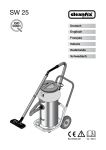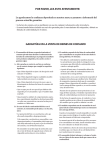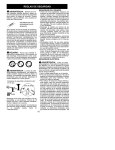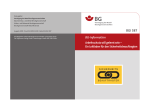Download S-Cap-Air EN
Transcript
S-Cap-Air EN Deutsch............................3 English .............................8 Italiano ...........................13 Español..........................18 2 Inhalt Seite 1 2 2.1 2.2 2.3 2.4 3 4 4.1 4.2 5 6 7 7.1 7.2 8 Hinweis für den Kunden ................................................................................................. 4 Technische Beschreibung .............................................................................................. 4 Allgemeines ....................................................................................................................... 4 Druckluft-Flasche und Tasche........................................................................................... 4 Druckminderer / Flaschenventiel ....................................................................................... 4 Haube ................................................................................................................................ 4 Anlegen und Benutzung ................................................................................................. 5 Nach dem Gebrauch........................................................................................................ 6 S-Cap-Air wurde mitgeführt, jedoch nicht benutzt ............................................................ 6 S-Cap-Air wurde mitgeführt und benutzt........................................................................... 6 Befüllen der Druckluft-Flasche....................................................................................... 6 Verpacken des Gerätes ................................................................................................... 6 Überprüfungen................................................................................................................. 7 Regelmäßige Überprüfung ................................................................................................ 7 Jährliche Überprüfung ....................................................................................................... 7 Bestellangaben ................................................................................................................ 7 ACHTUNG! Diese Gebrauchsanleitung weist gem. § 3 des Gesetzes über technische Arbeitsmittel auf bestimmungsgemäße Verwendung des Produktes hin und dient zur Verhütung von Gefahren. Sie muß von allen Personen gelesen und beachtet werden, die dieses Produkt einsetzen bzw. verwenden, pflegen, warten und kontrollieren. Dieses Produkt kann seine Aufgaben, für die es bestimmt ist, nur dann erfüllen, wenn entsprechend den Angaben von MSA AUER eingesetzt bzw. verwendet, gepflegt, gewartet und kontrolliert wird. Die von MSA AUER für dieses Produkt übernommene Garantie verfällt, wenn es nicht entsprechend den Angaben von MSA AUER eingesetzt bzw. verwendet, gepflegt, gewartet und kontrolliert wird. Vor Auswahl und Einsatz des Produktes muß eine Bewertung vorgenommen werden, ob es für die vorgesehene Anwendung geeignet ist. Auswahl und Einsatz unterliegen nicht dem Einfluß von MSA AUER. Unsere Haftung bezieht sich nur auf die gleichbleibende Qualität des Produktes. Das Vorstehende ändert nicht die Angaben über Gewährleistung in den Verkaufs- und Lieferbedingungen von MSA AUER. Das in dieser Gebrauchsanleitung beschriebene Gerät entspricht der Richtlinie 89/686/EWG. HINWEIS Das in dieser Gebrauchsanleitung beschriebene Gerät der Baureihe S-Cap-Air entspricht der Richtlinie 89/686/EWG. Es ist ein Druckluft-Selbstretter mit Haube nach EN 1146. 3 1 1. 2. 3. 4. 5. 6. 7. 8. 9. Hinweis für den Kunden S-Cap-Air ist nur für Flucht und Selbstrettung, jedoch nicht für Arbeitseinsätze einzusetzen. S-Cap-Air ist nicht für Unterwassereinsätze zu verwenden. S-Cap-Air ist nicht für Rettungseinsätze und/oder Brandbekämpfung zu verwenden. Falls S-Cap-Air über 5 kg wiegt, (dies ist mit der 3L 200bar Stahlflasche der Fall) soll das Gerät gemäß EN 1146 nicht ständig während einer Arbeitsschicht mitgeführt werden. S-Cap-Air ist geeignet für Erwachsene in guter physischer und psychischer Verfassung. Regelmäßiges Training und die Kenntnis der Gebrauchsanleitung werden vorausgesetzt. Mögliche Fluchtwege sind immer so zu planen, daß sie innerhalb der Haltezeit von S-Cap-Air sicher bewältigt werden können. S-Cap-Air ist arbeitstäglich zu überprüfen. Bei fehlender Plombe oder nicht vollständig befüllter Druckluft-Flasche, bzw. sonstigen Fehlern muß das Gerät zur Überprüfung in den Service. Nur von MSA ausgebildetes und autorisiertes Servicepersonal darf Prüfungen und Reparaturen an S-Cap-Air durchführen. Die Transportverpackung für S-Cap-Air ist in Übereinstimmung mit den geltenden Vorschriften auszuwählen. Nach dem Transport ist S-Cap-Air immer auf seine Einsatzfähigkeit hin zu überprüfen. (D.h. Sichtprüfung auf Beschädigungen, Überprüfung der Plombierung und des Füllzustandes anhand des Manometers.) 2 Technische Beschreibung 2.1 Allgemeines Das MSA AUER Druckluft-Selbstretter mit Haube S-Cap-Air ist für die Flucht und Selbstrettung aus schadstoffhaltigen Bereichen. S-Cap-Air ist leicht und einfach zu bedienen. Das Gerät liefert einen konstanten Luftstrom zur Atemluftversorgung in die Haube. Achtung S-Cap-Air ist ausschließlich für Notfälle zur Flucht und Selbstrettung zu verwenden. S-Cap-Air (3Liter, 200 bar) hat eine Einsatzzeit von 15 Minuten. Dies entspricht den Anforderungen der International Maritime Organization (IMO). Während der einfachen und eindeutigen Anlegeprozedur wird die Luftversorgung automatisch aktiviert, Luft strömt in die flexible Haube, welche leicht aufgesetzt werden kann und sofort Schutz bietet, auch für Bart- und / oder Brillenträger . 2.2 Druckluft-Flasche und Tasche Die Druckluft-Flasche entspricht der europäischen Richtlinie 97/23/ CEE. Die Druckluft-Flasche wird in der Tasche fixiert getragen. Das Manometer ist durch ein Fenster in der Tasche ablesbar. 4 Die Einsatzzeit und Piktogramme zur Verdeutlichung der Anlegeprozedur befinden sich auf der Tasche. Durch das Reißen an der Schlaufe wird die Luftversorgung aktiviert, die Plombe bricht, die Tasche öffnet sich und die Haube kann entnommen und angelegt werden. Beachten! Nur Atemluft gemäß den Anforderungen der EN 12021 oder USCGA grade D (oder besser) verwenden. Beachten! Die verwendeten Druckluft-Flaschen müssen den nationalen Anforderungen entsprechen und für den entsprechenden Druck zugelassen sein. 2.3 Druckminderer / Flaschenventil Das Ventil ist fest in die Druckluft-Flasche eingeschraubt. Am Ventil befindet sich die Ventilkappe mit dem eingesteckten Starterstift. Durch das Reißen an der Schlaufe wird der Starterstift am Ventil herausgezogen, das Ventil öffnet und die Luftversorgung ist aktiviert. Die Luft strömt aus dem Ventil über einen flexiblen Schlauch durch den Warn-Indikator in die Haube. Der ständige Luftstrom versorgt den Gerätträger mit Atemluft und verhindert einen Kohlendioxidanstieg in der Haube. Das Manometer am Ventil zeigt jederzeit den Füllzustand der Druckluft-Flasche an. 2.4 Haube Die signal-gelbe Haube ist mit einer großen Sichtscheibe, einer Halbmaske mit außenliegendem Ausatemventil und einem Warn-Indikator, der direkt im Blickfeld liegt ausgestattet. Die Atemluft gelangt über einen Schlauch durch den WarnIndikator in die Haube. Beim Einsatz des Gerätes füllt sich die Haube ständig mit frischer Atemluft und bildet ein Luftreservoir. Hieraus wird die frische Luft über die Halbmaske eingeatmet und anschließend über das Ausatemventil aus der Haube in die Umgebungsatmosphäre ausgeatmet. Die Sichtscheibe bietet ein sehr großes Sichtfeld. Der Warn-Indikator zeigt jederzeit den vorhanden korrekten Luftstrom (Anzeige: grün) an und warnt durch Farbwechsel (Anzeige: rot) den Benutzer zum Ende der Haltezeit die Haube abzunehmen. Die Innenbänderung der Haube bietet eine automatische, einfache und leichte Positionierung der Halbmaske über Nase, Mund und Kinn. Die gut sitzende Halbmaske und die konstante Luftversorgung verhindern einen Kohlendioxid Anstieg in der Haube. Die dichtsitzende, flexible Nackendichtung benötigt kein Einstellen nach dem korrekten Anlegen der Haube. 3 Anlegen und Benutzung 1 2 S-Cap-Air dem Aufbewahrungsort entnehmen und mit dem Nackenband um den Hals hängen.. Tasche festhalten, nicht das Ventil, die Aufreißschlaufe greifen und nach oben reißen. Der Luftstrom ist hörbar. Prüfen, ob der Starterstift vollständig herausgezogen wurde. Ist dies nicht der Fall, Ventil greifen und die Ventilkappe vom Ventil vollständig abschrauben. 3 Hände in die Halsdichtung der Haube stecken und diese weiten, Haube über den Kopf ziehen. Sitz der Halbmaske prüfen, ggf. korrigieren. Halsdichtung soll glatt am Hals anliegen; es dürfen keine Haare oder Kleidung eingeklemmt sein. SICHERHEITSHINWEIS ! Dieser Schritt startet die Luftversorgung und die Haltezeit beginnt. 4 5 6 Indikator im Blickfeld prüfen. GRÜN: Korrekte Luftversorgung in die Haube ROT: Ende der Haltezeit Leibgurt schliessen und einstellen. Ruhig und besonnen flüchten. Haube nicht vor dem Verlassen der Gefahrenzone absetzen. Achtung Warnhinweis! Wenn sich die Füllung der Druckluft-Flasche dem Ende nähert, zeigt dies der Indikator durch den Farbwechsel nach ROT an, die CO2-Konzentration in der Haube steigt an und die Haube muß abgesetzt werden. Benutzte Geräte müssen durch ausgebildetes Personal instandgesetzt werden. 5 4. 4 Nach dem Gebrauch 4.1 S-Cap-Air wurde mitgeführt, jedoch nicht benutzt: 10. Sichtprüfung auf etwaige Beschädigungen. Beschädigte Teile ersetzen, bzw. Gerät in den Service geben. 5. 11. Füllzustand der Druckluft-Flasche mit Manometer prüfen ob Anzeige im grünen Bereich. Verplombung prüfen. Gerät ggf. befüllen bzw. in den Service geben. 12. Gerät ggf. äußerlich säubern. 13. Gerät an den Aufbewahrungsort zurückbringen. 4.2 S-Cap-Air benutzt: wurde mitgeführt und 1. Achtung! Das Gerät nicht in Reinigungslösungen oder Wasser eintauchen 2. Haube und Schlauch vom Ventil trennen. 3. Haubeninnen- und Außenseite mit einem feuchten Tuch gründlich reinigen und mit Desinfektionstuch desinfizieren. Anschließend mit einem fusselfreien weichen Tuch trocken reiben. 4. Halbmaske mit einem milden Desinfektionsmittel desinfizieren, klarspülen und trocknen (direktes Sonnenlicht oder Hitzestrahlung vermeiden). 5. Druckluft-Flasche befüllen (siehe unten) 6. Bei Bedarf das Haubenvisier innen mit Antibeschlagmittel (D2260 700) behandeln. 7. Gerät verpacken (siehe unten). 8. Gerät an den Aufbewahrungsort zurückbringen. 5 2. 3. 6 7. 8. 9. 6 Plombe bzw. Plombenreste ggf. entfernen und den Reißverschluß vollständig öffnen. Haube herausnehmen, Ventil freilegen und Auslösevorrichtung überprüfen. Der Starterstift ragt aus der Kappe heraus [der Starterstift ist parallel zum Schlauchanschluß nach oben ausgerichtet] und das Ventil ist geschlossen [Kappe ist handfest aufgeschraubt]. Schutzkappe vom Füllstutzen am Ventil entfernen. Verpacken des Gerätes 1. Nach dem Befüllen des Gerätes und Verschließen des Füllanschlusses wird die angeschlossene Haube verpackt, indem der Luftführungsschlauch die Druckluft-Flasche entlang zum Ende geführt und dann die Haube in Gegenrichtung oben auf gelegt wird, wobei diese (bei korrekter Packlage) nicht an das Ventil heranreicht. 2. Der Haken am Ende des Aufreißbandes wird in den Starterstift eingehakt. Das Aufreißband soll nicht verdreht und frei beweglich sein und oben auf der Haube liegen. 3. Nun den Reißverschluß vollständig bis an das Ende über den Zahn-Ausschnitt in der Reißverschlußkette hinaus schließen. Dabei ist die Haube in Packlage zu halten, darauf zu achten, daß in den Reißverschlußzähnen nichts eingeklemmt wird und die Aufreißschlaufe außerhalb der Tasche ist. 4. Sicherstellen, daß das Manometer im Taschenfenster sichtbar ist. [Haube ist nicht im Fenster sichtbar]. 5. Die Taschen-Lasche durch die schlaufe legen und somit fixieren. Befüllen der Druckluft-Flasche Achtung! Nur Atemluft gemäß den Anforderungen der EN 12021 oder USCGA grade D (oder besser) verwenden. Kompressoren und Fülleinrichtungen sind ausschließlich von geschultem Personal zu bedienen. Alle Warn- und Sicherheitshinweise sind zu beachten. 1. 6. Füllstutzen mit einem 200 bar Füllanschluß verbinden und auf 207 bar befüllen. (Anleitung des Kompressors beachten und ggf. notwendige Adapter verwenden.) Nach dem Füllen das Ventil kurz durch Losschrauben der Kappe öffnen, anschließend sofort wieder schließen, bis der Luftstrom stoppt. Zusätzlich noch weitere 45° ± 15° zuschrauben. Jetzt muß der Starterstift parallel zum Schlauchanschluß ausgerichtet sein. Ist dies nicht der Fall, Kappe nochmals lösen und Starterstift entfernen und auf der gegenüberliegenden Seite in die Kappe einstecken und Ventil erneut, wie oben erklärt, schließen. Hinweis : Das zusätzliche Festschrauben der Kappe mit einer Drehung von 45° ± 15° über den Punkt ‘Ventil geschlossen‘ [kein Luftstrom am Auslass] hinaus, sorgt für ein korrekt dicht geschlossenes Ventil. Ein zu festes Aufschrauben der Kappe würde bei der Aktivierung die Aufreißkraft erheblich vergrößern. Normalerweise ist ein Nachfüllen der Druckluft-Flasche nicht erforderlich Nach dem Füllen den Füll-Anschluss entlüften und die drucklose Verbindung lösen (ggf. Adapter entfernen). Füllzustand überprüfen, Manometeranzeige ist nach dem Abkühlen auf Raumtemperatur im grünen Bereich. Füllstutzen mit Schutzkappe wieder verschließen. Gerät verpacken (siehe unten). Aufreiß- 6. Die Plombe wird durch die Ösen der Tasche gezogen, damit wird die Lasche fixiert und die Schlaufe des Aufreißbandes gesichert. Die Verplombung soll so eng als möglich, jedoch spannungsfrei und noch beweglich sein. 7. Jetzt ist S-Cap-Air einsatzbereit. (Wenn die Aufreißschlaufe hochgerissen wird, bricht die Plombe, der Starterstift wird aus der Ventilkappe herausgezogen und das Ventil öffnet, Luft strömt in die Haube, der Reißverschluß der Tasche öffnet sich und die Haube kann entnommen werden.) Verplombungsset (Best.-Nr. 10023512, Pg. mit 25 St.). 7 Überprüfungen 7.1 Regelmäßige Überprüfungen Alle einsatzfähigen Geräte sind monatlich zu überprüfen, auch wenn sie zentral gelagert werden. Personen zugeordnete Geräte sind bei Übergabe und anschließend arbeitstäglich zu überprüfen. Geräte, die ortsgebunden zum sofortigen Notfalleinsatz gelagert werden, sind ebenfalls arbeitstäglich zu prüfen. 1. 2. 3. 4. Manometer-Kontrolle Druckluft-Flasche muß vollständig gefüllt sein Allgemeine Zustands-Kontrolle Gerät und Tasche sind sauber und unbeschädigt Plomben-Kontrolle Plombe ist einwandfrei und unbeschädigt Zugangs-Kontrolle Zugriff auf das Gerät darf nicht verstellt oder versperrt sein Geräte, die eine Kontrolle nicht bestehen und die zur jährlichen Überprüfung anstehen, müssen zum Service gegeben werden. 7.2 7.2.2 Funktionsprüfung Neben der Sicht- und Materialüberprüfung wird die korrekte Funktion des Gerätes überprüft. Hierzu wird das gefüllte Gerät gestartet und der Warnindikator überprüft. Nach dem Start muß die Anzeige grün sein. Nach mindestens 15 Minuten und maximal 21 Minuten muß die Anzeige nach rot wechseln. Während dieser Prüfzeit muß die Druckanzeige des Manometers von voll nach leer wechseln, Die Überprüfung ist zu protokollieren, mit den entsprechenden Befunden und Details sowie der Serial Nummer - auf dem Gerät ist der Zeitpunkt der nächsten jährlichen Überprüfung zu vermerken. Nach erfolgreicher Überprüfung wird das Gerät gemäß dieser Anleitung gefüllt und verpackt. Achtung! Bei Schäden oder Funktionsstörungen muß das Gerät in den Service geben werden. 8 Bestellangaben Bezeichnung S-Cap-Air, Flasche ungefüllt S-Cap-Air, Flasche gefüllt S-Cap-Air light, Flasche ungefüllt S-Cap-Air light, Flasche gefüllt Tasche S-Cap-Air, Ersatz Haube S-Cap-Air, Ersatz Clip (Pckg. mit 5 Stück) Filter, Filzscheiben S-Cap-Air (Pckg. mit 10 Stück) Ventilkappe und Starterstift O-Ring für Anschlußstück (Pckg. mit 10 Stück) Plomben Kit (25 Stück) Bestell-Nr. 100 17 668 100 32 181 100 33 919 100 34 561 100 18 520 100 19 481 100 19 483 100 19 508 100 19 484 100 24 118 100 23 512 Jährliche Überprüfung 7.2.1 Sichtkontrolle Überprüfung auf mechanische Beanspruchungen wie Risse, Materialbrüche, Schnitte, Abschürfungen oder sonstige Materialveränderungen an den folgenden Teilen: - Tragetasche, Bänderung und der Startauslösungevorrichtung. - Luftführungsschlauch und Anschlußstückmit ORing. Verhärtete und oder brüchige Schläuche sind zu ersetzen. O-Ringe sind als Ersatzteile erhältlich [Best.-Nr.: 10024118 (Pg. mit 10 St.)]. - Haube, Nackendichtung und Halbmaske. Die Ventilscheibe im Ausatemventil ist spätestens alle 3 Jahre zu ersetzen. Ersatzteile sind erhältlich [Best.-Nr. : D2055749 (Pg. mit 10 St.)] - Flaschen-Ventil / Druckminderer und Manometer - Druckluft-Flasche, Überprüfungen gemäß den nationalen Bestimmungen sind durchzuführen (z.B. TÜV-Prüfungen) 7 Contents Page 1 2 2.1 2.2 2.3 2.4 3 4 4.1 4.2 5 6 7 7.1 7.2 8 Important Information to User ........................................................................................ 9 Technical Description...................................................................................................... 9 General .............................................................................................................................. 9 Cylinder and Bag................................................................................................................ 9 Regulator / Cylinder Valve.................................................................................................. 9 Hood................................................................................................................................... 9 Donning and Use ............................................................................................................ 10 After Use .......................................................................................................................... 11 When S-Cap-Air has been worn but not operated ........................................................... 11 When S-Cap-Air has been worn and operated ................................................................ 11 Charging .......................................................................................................................... 11 Packing ............................................................................................................................ 11 Checks ............................................................................................................................. 12 Regularly Check................................................................................................................ 12 Once a Year ...................................................................................................................... 12 Ordering Information ...................................................................................................... 12 Notice! Like any piece of complex equipment, this MSA AUER product will do the job it is designed to do only, if it is used and serviced in accordance with the manufacturer’s instructions. This manual must be carefully read by all individuals who have or will have responsibility for using or servicing this product. The warranties made by MSA AUER with respect to this product are voided if the product is not used and serviced in accordance with the instructions in this manual. Before choosing and using this product, it is required to assess whether it is suitable for the application intended. Selection and use are beyond the control of MSA AUER. Therefore, the liability of MSA AUER covers only the steady quality of this product. The above does not alter statements regarding the warranties and conditions of sale and deliveries of MSA AUER. The S-Cap-Air apparatus described in these Instructions for Use is in accordance with Directive 89/686/EEC. It is a compressed air escape apparatus with hood according to EN 1146. 8 1 1. 2. 3. 4. 5. 6. 7. 8. 9. Important Information to User The S-Cap-Air apparatus is designed for emergency situations only and should not be used for entry or re-entry into irrespirable atmospheres. The MSA escape apparatus S-Cap-Air is not to be used for underwater escape activities. The S-Cap-Air is not for rescue or fire fighting purposes. If the S-Cap-Air weighs more than 5 kg, it must not be worn during a complete work shift according to EN 1146. (Normally the S-CapAir with steel cylinder weighs more than 5 kg.) Only adults in good physical and physiological condition should use the S-Cap-Air. The user of S-Cap-Air must have received full training in its use and have read and understood this manual before using. Always ensure that the length of the escape route is within the duration stated on the S-Cap-Air. If the anti-tamper tag is broken the apparatus must be checked, recharged if required, and a new tag applied. Only holders of a valid MSA Service Certificate may carry out full service and test of SCap-Air. 2.2 Cylinder and Bag The compressed air cylinder is manufactured in accordance with the Directive 97/23/EEC. It is carried and fixed in the bag. The pressure gauge is readable through a window. The duration time for the apparatus and pictorial user instructions are noted on the bag. When pulling the firing strap the anti-tamper tag breaks the airflow starts and the bag is opened so that the hood can be taken and be pulled over the head. Note! The air supply shall meet the requirements for breathable air of EN 12021 or USCGA grade D (or better). Note! The compressed air cylinder used with this apparatus shall comply with national regulations. The cylinder shall be approved with respect to the appropriate pressure. 2.3 Regulator / Cylinder Valve The regulator is mounted on the cylinder. The regulator has a quick start function. By pulling the firing strap the cylinder valve is opened in one movement. When the firing pin is drawn the airflow starts. It is essential that the S-Cap-Air are transported in suitable packaging with due regard to all applicable legislation. After transportation ensure that the bag and contents including the gauge have not been damaged and that the anti-tamper tags are intact. From the outlet of the regulator a flexible hose leads the flow of air into the hood. The airflow minimizes CO2 build up. A constant reading pressure gauge is fitted to the regulator, providing a continuous indication of the cylinder pressure. 2 Technical Description 2.4 2.1 General The hood assembly consists of a bright yellow hood, an inner Mask, a visual alarm indicator in the field of vision and the air supply hose. The escape apparatus S-Cap-Air is a compressed air breathing apparatus to be used for emergency escape from irrespirable atmospheres. It has been designed and tested in accordance with EN 1146 to demonstrated compliance with safety requirements of EC Directive 89/686/EEC. Typeexamination performed by INSPEC; UK (Notifying Body: - Inspec Certification [0194] Upper Wingbury, Courtyard Wingrave, Aylesbury, Bucks, U.K.). The S-Cap-Air is a lightweight apparatus that is simple to use and gives a consistent flow of breathable air. Note! The S-Cap-Air apparatus is to be used for emergency escape only The S-Cap-Air has duration of 15 minutes. This is the duration required by the International Maritime Organization (IMO). In the apparatus a fast positive method of operation permits air to pass from the compressed cylinder into a flexible hood which can be slipped over the head in a fast maneuver without complicated adjustment and provides protection to any wearer, including those with beard and/or spectacles. Hood When the S-Cap-Air is operated, the hood is filled with air and provides a reservoir of air. When the user takes a breath, air goes from the hood to the inner mask and will be inhaled. Exhalation goes through an exhalation valve from the inner mask to the ambient atmosphere. The visor is designed for maximum field of vision during escape. The visual indicator shows duration status information and indicates when to remove the hood as the cylinder is empties. The inner harness provides automatic and easy adjustment for the inner mask. The harness design guides the mask onto the user's face and assumes the correct position. The inner mask and the air supply prevent the build up of high levels of carbon dioxide. The neck seal accommodates a wide range of fits and needs no adjustments after donning. 9 3 Donning and Use 1 2 Remove the S-Cap-Air from its stowage. Put your head through the neck strap. Hold the bag, not the cylinder valve, pull the firing strap upwards. Listen for airflow. Check that the firing pin is fully withdrawn. If the firing pin is still in place, access the valve and unscrew the cap completely. SAFETY WARNING!: Duration of apparatus starts now. This action has started the airflow. Insert hands into the neck seal opening and pull the hood over the head. Adjust inner mask and neck seal to seal. Ensure that hair / clothing is not trapped under the neck seal. 4 5 6 Check the indicator in the visor. GREEN : OK RED: End Of Duration Tighten waist belt. Make your escape from the area. Do not remove hood until well clear of danger. 3 Note! When the cylinder is almost empty the green warning disc, visible inside the hood, will change to red, CO2 will start to increase and the hood must be removed. Once the S-Cap-Air has been used it must be returned for servicing and maintenance, including recharging, by trained personnel. 10 4 After Use 4.1 When S-Cap-Air has been worn but not operated: 1. Examine the apparatus for any signs of damage. Damaged parts shall be replaced or sent for service. 2. Check that the cylinder is fully charged and the anti-tamper tag is intact. If not, send the apparatus for service / charging. 3. Clean the bag if necessary. 4. Replace the apparatus to its storage point. 4.2 When S-Cap-Air has been worn and operated: 1. Caution: Do not immerse the device 2. Remove the hood and supply hose from the regulator 3. Clean the internal and the external surface of the hood with a damp cloth and a Sanitizing Wipe. Dry the above with a soft lint free cloth. 4. Clean the inner mask with a mild disinfectant sanitizing wipe. 5. Recharge the cylinder as described under Charging. 6. Demisting Solution [Part No. D2260 700] is available to polish the visor if this is necessary 7. Pack the apparatus as described under Packing. 8. Replace the apparatus in its storage point. 5 Charging Note! Air used to charge cylinders must conform to EN 12021 or USCGA grade D (or better). High pressure compressors and charging apparatus must only be used by trained operators and all safety procedures must be observed. 1. Break the tamper proof tag (if necessary) and open the zipper on the bag to its full length. 2. Uncover the valve arrangement and check that the firing pin is in place [the head of the pin should be on the same side as the outlet port] when the cap is tightly screwed into valve closed position. 3. Remove the dust cap from the charging port on the cylinder valve 4. Connect to a suitable [200 bar] supply using any necessary adapters and charge the cylinder to 207 bar. 5. When the cylinder is full close the supply valve of the charging system to the S-Cap-Air and vent the connection to atmosphere. Open the valve by turning the cap counterclockwise until the airflow starts, then immedi- 6. 7. 8. 6 ately close the valve until the airflow just stops. Now turn the cap clockwise 45° ± 15°. Check the position of the firing pin. The head of the pin should still be on the same side as the outlet port. If this is not the case quickly slacken the cap, remove the pin and replace it in the correct orientation. Close the valve until the airflow just stops and then turn the cap clockwise 45° ± 15°. Attention: Turning the cap through an angle of approx. 45° is done to ensure that adequate, air tight sealing of the valve is achieved. Turning the cap through greater angles may result in excessively high pull out forces for the firing pin. Check the cylinder pressure and top up if necessary. Topping up will not normally be required. Remove any charging adapters used. The cylinder pressure gauge reading (cylinder at room temperature) must be clearly in the green section. Replace the dust cap on the charging port. Complete the packing of the S-Cap-Air as described below. Packing 1. Once the cylinder is fully charged the dust cap must be replaced on the charging port. The reconnected hood is packed by laying the hose along the top of the cylinder away from its connection point towards the closed end of the zipper and then laying the hood back towards the regulator, it should not reach the regulator if packed correctly. 2. Connect the clip at the end of the strap to the firing pin and check that the strap is not tangled and is free to move. The strap lays on top over the packed hood. 3. Ensuring that no material is trapped in the teeth close the zip until it is passed the break point in the zip teeth, holding the hood in place, keeping the loop in the strap out side the bag 4. Make sure that the pressure gauge is readable through the bag window [you should not see the hood]. 5. Fold the flap over and feed the strap loop through it to trap it. 6. Feed the anti tamper tag through the eyelets in the bag and flap but under the strap loop and close the tag. Adjust the size of the tag loop such that it is as small as possible but still slightly loose. The tag should not be under tension. 7. The S-Cap-Air is now in its ready for use state. (When the firing strap is pulled the tamper proof tag breaks.The firing pin is pulled from the cylinder valve, airflow commences and the zipper opens.) 11 7 Checks 7.1 Regularly Checks It is mandatory that all escape equipment be checked at monthly intervals, even in a central store. In addition apparatus issued to individuals should be checked at issue and then daily. Apparatus in ready to use lockers should also be checked daily. 1. Check that the contents gauge shows fully charged. 2. Check that the bag is clean and undamaged. 3. Check that the anti-tamper tag is located and unbroken. 4. Check that access to the bag is unobstructed. Apparatus that fails any of these checks must be withdrawn and sent for maintenance and at scheduled annual service intervals 7.2 Once a Year 7.2.1 Visual Inspection Check that there are no mechanical damages such as cuts, tears, abrasions or mechanical damages on the following parts: - The carrying bag, straps / bands and the firing mechanism - The air hose connectors and O-rings. Excessively stiff hoses should be replaced with new ones. Hose connection port O-rings are available as spares [MSA part no. 10024118; (10 pcs)] - Hood, neck seal and mask. The valve disc in the exhalation valve must be replaced every 3 years and spares are available D2055 749 (10 pcs)]. - Cylinder valve / first stage regulator and pressure gauge - Cylinder, check that the cylinder is tested according to local and national regulations 7.2.2 Functional Checks In addition to the visual inspection described the device should be tested to ensure that it functions correctly. Operating the device performs this test and checking that the flow alarm indicator remains green until a minimum of 15 minutes [and maximum of 21 Minutes] has elapsed before turning red. The pressure gauge must indicate from full to empty during the test. Once the inspection and tests are complete the cylinder should be recharged and made ready for service as described in the charging and packing sections. Record inspection and test of the S-Cap-Air including details of the actual date and serial number of the set. Any damaged parts must be replaced before it can be returned to service and all malfunctions corrected. Note! Any signs of damage or malfunction: Send for service or replace necessary parts. 12 8 Ordering Information Description S-Cap-Air, Cylinder empty S-Cap-Air, Cylinder charged S-Cap-Air light, Cylinder empty S-Cap-Air light, Cylinder charged Bag S-Cap-Air, Spare Hood assembly, Spare Clip (pcs 5) Felt Disc (pcs 10) Cap and Firing Pin Connection Port O-Ring (pcs 10) Anti-tamper tag kit (pcs 25) Part Number 100 17 668 100 32 181 100 33 919 100 34 561 100 18 520 100 19 481 100 19 483 100 19 508 100 19 484 100 24 118 100 23 512 Indice Page 1 2 2.1 2.2 2.3 2.4 3 4 4.1 4.2 5 6 7 7.1 7.2 8 Informazioni importanti per l’Operatore....................................................................... 14 Descrizione Tecnica ....................................................................................................... 14 Informazioni Generali........................................................................................................ 14 Bombola e Borsa .............................................................................................................. 14 Regolatore / Valvola bombola........................................................................................... 14 Cappuccio......................................................................................................................... 14 Indossamento e Utilizzo................................................................................................. 15 Dopo l’uso ....................................................................................................................... 16 Quando S-Cap-Air è stato indossato, senza essere messo in funzione.......................... 16 Quando S-Cap-Air è stato indossato e messo in funzione .............................................. 16 Ricarica ............................................................................................................................ 16 Imballo ............................................................................................................................. 16 Controlli ........................................................................................................................... 17 Controlli regolari................................................................................................................ 17 Annualmente..................................................................................................................... 17 Numeri di catalogo ......................................................................................................... 17 Avvertenza! Come ogni componente di attrezzatura complessa, questo prodotto MSA AUER espleterà la funzione preposta, esclusivamente se il suo uso e la sua manutenzione avverranno in conformità con le istruzioni fornite dal produttore. Tutti coloro responsabili dell’uso e della manutenzione del prodotto dovranno leggere attentamente le istruzioni contenute in questo manuale. Le garanzie concesse da MSA AUER relative a questo prodotto saranno ritenute nulle qualora il suo uso e la sua manutenzione non avvenissero conformemente alle istruzioni contenute in questo manuale. Prima di scegliere e utilizzare questo prodotto, è necessario stabilire che sia adatto per il tipo di applicazione intesa. La scelta e l’uso del prodotto sono fuori dal controllo di MSA AUER. Quindi, la responsabilità di MSA AUER riguarda solo la qualità dello stesso. Quanto sopra non modifica le dichiarazioni in merito alle garanzie ed alle condizioni di vendita e fornitura di MSA AUER. L’apparecchio S-Cap-Air descritto in queste Istruzioni per l’Uso è conforme alla Direttiva 89/686/CEE. Si tratta di un apparecchio di fuga ad aria compressa con cappuccio conforme alla norma EN 1146. 13 1 1. Informazioni importanti per l’Operatore L’apparecchio S-Cap-Air è stato realizzato esclusivamente per situazioni di emergenza e non deve essere usato per entrare o rientrare in atmosfere irrespirabili. 2. L’apparecchio di emergenza MSA S-Cap-Air non deve essere usato per operazioni subacquee 3. L’S-Cap-Air non è stato realizzato operazioni di salvataggio o antincendio 4. Se l’S-Cap-Air ha un peso maggiore a 5 kg, non deve essere indossato per un turno di lavoro completo conformemente alla norma EN 1146. (Solitamente il peso di S-Cap-Air con bombola in acciaio è maggiore a 5 kg.) 5. S-Cap-Air deve essere utilizzato soltanto da operatori adulti in buone condizioni fisiche. 6. L’operatore che utilizza S-Cap-Air deve aver seguito un corso di addestramento completo sull’uso dell’apparecchio e letto il manuale di istruzioni prima dell’uso. per 7. Assicurasi sempre che la lunghezza del percorso di fuga corrisponda alla durata specificata sull’S-Cap-Air. 8. Se il sigillo anti-manomissione non è intatto, controllare l’apparecchio, se necessario provvedere alla ricarica e applicare un nuovo sigillo. 9. Solo coloro che dispongono di un Certificato di Assistenza MSA possono effettuare assistenza e controlli completi dell’apparecchio S-Cap-Air. E’ importante che l’ S-Cap-Air sia trasportato in apposita borsa, tenendo in considerazione tutte le normative vigenti. Dopo il trasporto assicurarsi che la borsa ed il suo contenuto, compreso il manometro, non abbiano subito danni e che i sigilli anti-manomissione siano ancora intatti. 2 Descrizione Tecnica 2.1 Informazioni Generali S-Cap-Air è un respiratore ad aria compresa da utilizzare in casi di emergenza, nei casi in cui è necessario abbandonare un’atmosfera irrespirabile. E’ stato realizzato e sottoposto a controlli conformemente alla norma EN 1146 per dimostrare la conformità con i requisiti di sicurezza della Direttiva 89/686/CEE. Omologazione eseguita da INSPEC UK (Organismo Notificato: - Inspec Certification [0194] Upper Wingbury, Courtyard Wingrave, Aylesbury, Bucks, U.K.). S-Cap-Air è un apparecchio leggero, semplice da utilizzare che fornisce un flusso costante di aria respirabile. Nota! L’apparecchio S-Cap-Air deve essere usato solo in situazioni di emergenza La durata di S-Cap-Air corrisponde a 15 minuti. Si tratta della durata richiesta dall’ Organizzazione Marittima Internazionale (IMO). Grazie al metodo di funzionamento rapido, l’aria passa dalla bombola di aria compressa in un 14 cappuccio flessibile che può essere indossato velocemente senza necessità di effettuare complicate regolazioni e garantisce la protezione per qualsiasi operatore, compresi coloro con barba e/o occhiali. 2.2 Bombola e Borsa La bombola di aria compressa è realizzata conformemente alla Direttiva 97/23/CEE. E’ trasportata e fissata nella borsa. Il manometro è leggibile attraverso una “finestrella” trasparente. Sulla borsa sono indicati la durata dell’apparecchio ed alcuni pittogrammi relativi all’uso dello stesso. Quando viene tirata la cinghia di attivazione, il sigillo anti-manomissione si rompe, si attiva il flusso d’aria e la borsa si apre ed è quindi possibile sfilare il cappuccio e indossarlo. Nota! L’alimentazione dell’aria deve corrispondere ai requisiti per l’aria respirabile della norma EN 12021 o USCGA Grado D (o migliore). Nota! La bombola di aria compressa usata con questo apparecchio deve essere conforme alle normative nazionali. La bombola deve essere adeguata alla pressione utilizzata. 2.3 Regolatore / Valvola bombola Il regolatore è montato sulla bombola. Il regolatore dispone di una funzione di “avvio rapido” (quick start). Tirando la cinghia di attivazione, la valvola della bombola si apre con un unico movimento. Quando si estrae il perno di attivazione, parte il flusso d’aria. Dall’uscita del regolatore, un tubo flessibile conduce il flusso di aria nel cappuccio. Il flusso d’aria minimizza la formazione di CO2. Un manometro di pressione a lettura costante è collegato al regolatore, garantendo un’indicazione continua della pressione della bombola. 2.4 Cappuccio Il gruppo del cappuccio consiste di un cappuccio giallo brillante, di una maschera interna, di un indicatore di allarme posto nel campo visivo e di un tubo flessibile di alimentazione dell’aria. Quando S-Cap-Air è in funzione, il cappuccio è pieno di aria e funge da serbatoio di aria. Quando l’operatore respira, l’aria passa dal cappuccio alla maschera interna e viene inalata. L’aria esalata passa, attraverso una valvola di esalazione, dalla maschera interna all’atmosfera ambiente. Il visore è realizzato per disporre del massimo campo visivo durante l’emergenza. L’indicatore visivo indica le informazioni sul tempo di utilizzo e segnala quando è il momento di togliere il cappuccio perché la bombola è vuota. La bardatura permette una regolazione semplice e automatica della maschera interna. Il design della bardatura guida la maschera sul viso dell’operatore, garantendone l’esatto posizionamento. La maschera interna e l’alimentazione prevengono la formazione di alti livelli di biossido di carbonio. La guarnizione di tenuta del collo garantisce un’ampia adattabilità e non necessita regolazioni dopo l’indossamento. 3 Indossamento e Utilizzo 1 Togliere S-Cap-Air dalla sua custodia. Far passare la testa nella tracolla. 4 Controllare l’indicatore sul visore. VERDE: OK ROSSO: Fine tempo di utilizzo 2 Tenere la borsa, non la valvola della bombola, tirare la cinghia verso l’alto. Ascoltare il flusso. Controllare che il perno di attivazione sia estratto. dell’aria. Se il perno è ancora in posizione, svitare completamente il cappuccio della valvola. AVVERTENZA DI SICUREZZA!: Da questo momento parte il tempo di utilizzo dell’apparecchio. Questa azione ha attivato il flusso d’aria. 5 Stringere la cinghia di fissggio sui fianchi.. 3 Inserire le mani nell’apertura della guarnizione di tenuta del collo e posizionare il cappuccio sulla testa. Regolare la maschera interna e la guarnizione di tenuta del collo per garantirne la tenuta. Assicurarsi che sotto la guarnizione di tenuta del collo non siano rimasti intrappolati capelli o indumenti. 6 Allontanarsi dalla zona. Non togliere il cappuccio fino a quando non si è fuori pericolo. Nota! Quando la bombola è quasi vuota, l’indicatore – visibile all’interno del cappuccio – passerà da verde a rosso. La concentrazione di CO2 comincerà ad aumentare ed il cappuccio deve essere tolto. Una volta terminato l’utilizzo di S-Cap-Air, lo stesso deve essere sottoposto a personale addestrato per le operazioni di assistenza e manutenzione, compresa la ricarica. 15 4 Dopo l’uso 4.1 Quando S-Cap-Air è stato indossato, senza essere messo in funzione. 1. Controllare che sull’apparechio non vi siano danneggiamenti. Le parti danneggiate devono essere sostituite o rese per la riparazione. 2. Controllare che la bombola sia completamente carica e che il sigillo anti-manomissione sia intatto. In caso contrario, rendere l’apparecchio per la riparazione/ricarica. 3. Pulire la borsa, se necessario. 4. Riposizionare l’apparecchio al suo posto. 4.2 Controllare la posizione del perno di attivazione. La testa del perno di attivazione deve essere sempre sullo stesso lato della porta di uscita aria. Se così non fosse, aprire rapidamente il tappo, togliere il perno di accensione e sostituirlo nella direzione giusta. Chiudere la valvola fino a quando non si ferma il flusso d’aria e poi ruotare il cappuccio in senso orario per 45° ± 15°. Attenzione: La rotazione del cappuccio di circa 45° viene eseguita per assicurare una tenuta adeguata della valvola. Una rotazione eccessiva del cappuccio potrebbe creare eccessiva tensione per il perno di attivazione. Controllare la pressione della bombola e, se necessario, riempirla. Normalmente questa operazione non si rende necessaria. Quando S-Cap-Air è stato indossato e messo in funzione. Togliere, se usati, eventuali adattatori di ricarica. La lettura del manometro della bombola (bombola a temperatura ambiente) deve essere ben visibile nella sezione verde. 7. Riposizionare il tappo connessione per la ricarica. 8. Imballare S-Cap-Air come descritto di seguito. Avvertenza: 2. Togliere il cappuccio ed il tubo flessibile di alimentazione dell’aria dal regolatore. 3. Pulire la superficie interna ed esterna del cappuccio con un panno umido e con fazzoletti disinfettanti. Asciugare con un panno morbido. 4. Pulire la maschera interna con un panno morbido, detergente e disinfettante. 6 5. Ricaricare la bombola come descritto al par. 5 1. 6. Soluzione antiappannante [Cat. D2260700] disponibile per lucidare il visore, se necessario 7. Confezionare l’apparecchio come da par. 6. 8. Riporre l’apparecchio nel luogo predisposto. Quando la bombola è stata ricaricata, riposizionare il tappo antipolvere sulla porta di ricarica. Posizionare il tubo flessibile ben disteso lungo la parte alta della bombola, distante dalla connessione, verso l’estremità chiusa della cerniera e poi stendere il cappuccio verso il regolatore. Se posizionato correttamente, non deve toccare il regolatore. 2. Collegare la clip all’estremità della cinghia al perno e controllare che non sia piegata ed il movimento sia libero. La cinghia risulta stesa sopra il cappuccio. 3. Assicurarsi che non ci sia del materiale tra i dentelli della cerniera, chiuderla fino in fondo, mantenendo il “cappio” della fascetta esterno alla borsa custodia ed il cappuccio posizionato correttamente 4. Assicurarsi che il manometro sia leggibile attraverso la finestrella sulla borsa (non dovrebbe vedersi il cappuccio). 5. Posizionare l’aletta in modo da far passare il cappio della fascetta attraverso la stessa per bloccarla. 6. Far passare il sigillo anti-manomissione attraverso gli occhielli della borsa e dell’aletta ma sotto il cappio della fascetta. Chiudere il sigillo stringendolo in modo che abbia dimensioni ridotte, ma che risulti leggermente allentato. Il sigillo non deve essere in tensione. 7. S-Cap-Air è ora pronto per essere usato. (Quando la cinghia di attivazione viene tirata, il sigillo anti-manomissione si rompe. Il perno di attivazione viene estratto dalla valvola della bombola, il flusso d’aria parte e la cerniera si apre). 5 Ricarica Nota! 1. 2. Non immergere l’autorespiratore in acqua. 6. 1. L’aria utilizzata per la ricarica delle bombole deve essere conforme alla norma EN 12021 o USCGA grado D (o migliore). I compressori ad alta pressione ed il dispositivo di ricarica devono essere usati solo da operatori addestrati, in stretta osservanza delle procedure di sicurezza. Rompere il sigillo anti-manomissione (se necessario) e aprire completamente la cerniera sulla borsa Togliere il cappuccio della valvola e controllare che il perno di attivazione sia in posizione (la testa del perno deve essere sullo stesso lato della porta di uscita aria) quando il cappuccio è ben serrato nella posizione di valvola chiusa. 3. Togliere il tappo di protezione antipolvere dalla porta di ricarica sulla valvola della bombola. 4. Collegarla, utilizzando se necessario l’apposito adattatore, ad un’alimentazione dell’aria [200 bar], e ricaricare la bombola a 207 bar. 5. Quando la bombola è piena, chiudere la valvola di alimentazione del sistema di ricarica e depressurizzare la connessione all’S-Cap-Air. Aprire la valvola girando il cappuccio in senso antiorario fino a quando il flusso di aria parte, poi chiudere immediatamente la valvola fino a quando il flusso d’aria non si ferma. Ora ruotare il cappuccio in senso orario per 45° ± 15°. 16 antipolvere sulla Imballo 7 Controlli 7.1 Controlli periodici E’ obbligatorio che tutti gli apparecchi di emergenza siano controllati mensilmente, anche se tenuti a magazzino pronti per l’imiego. Inoltre, gli apparecchi dati in dotazione agli operatori devono essere controllati alla consegna e giornalmente. Gli apparecchi pronti per l’uso, conservati in appositi armadietti, devono essere controllati giornalmente. 1. 2. 3. 4. Controllare che il manometro indichi la completa carica della bombola. Controllare che la borsa sia pulita e non presenti danneggiamenti. Controllare che il sigillo anti-manomissione sia intatto. Controllare che l’accesso alla borsa sia libero. Gli apparecchi che non superano questi controlli devono essere ritirati e resi per la manutenzione. Tutti gli apparecchi devono inoltre essere inviati per la manutenzione ad intervalli annuali. 7.2 Nota! In caso si riscontrino parti con danneggiamenti o malfunzionamenti: inviare l’apparecchio per riparazione o sostituzione delle parti difettose 8 Numeri di catalogo Descrizione S-Cap-Air, bombola 3 l/200 bar, vuota S-Cap-Air, bombola 3 l/200 bar, carica Borsa S-Cap-Air, Ricambio Gruppo cappuccio, Ricambio Clip (5 pz) Disco in feltro (10 pz) Cappuccio e Perno di attivazione O-Ring Porta di collegamento (10 pz) Sigillo anti-manomissione (25 pz) Adattatore x ricarica bombola ( attacco filettatura Italia ) Codice 01 04 000 01 04 001 100 18 520 100 19 481 100 19 483 100 19 508 100 19 484 100 24 118 100 23 512 100 20 422 Annualmente 7.2.1 Controllo Visivo Controllare che non siano presenti danni meccanici, quali tagli, strappi, abrasioni o danni meccanici sulle seguenti parti: - borsa di trasporto, cinghie/nastri, meccanismo di attivazione. - connessioni della tubazione flessibile dell’aria e O-ring. Le tubazioni troppo rigide devono essere sostituite con tubazioni nuove. Gli O-ring delle connessioni del tubo flessibile dell’aria sono disponibili come parti di ricambio [MSA cat. 10024118; (10 pezzi)] - cappuccio, guarnizione di tenuta collo e maschera. La membrana della valvola di esalazione deve essere sostituita ogni 3 anni e sono disponibili le parti di ricambio. [ D2055 749 (10 pz)]. - gruppo valvola/regolatore della bombola e manometro indicatore pressione. - bombola, controllare che la bombola sia stata sottoposta a controllo secondo le normative locali e nazionali. 7.2.2 Controlli funzionali Oltre al controllo visivo descritto, l’apparecchio deve essere sottoposto a controlli per assicurare il corretto funzionamento. Il controllo consiste nel verificare che l’indicatore di allarme di flusso resti verde minimo per 15 minuti (e massimo 21 minuti) prima di diventare rosso. Il manometro deve indicare lo stato da pieno a vuoto durante il controllo. Una volta completati i controlli, la bombola deve essere ricaricata e approntata per l’utilizzo come descritto ai relativi punti. Registrare la verifica ed i controlli effettuati sull’S-Cap-Air, aggiungendo la data di esecuzione ed il numero di serie dell’apparecchio. In caso di parti danneggiate, provvedere alla loro sostituzione o riparazione. 17 Contenido Página 1 2 2.1 2.2 2.3 2.4 3 4 4.1 4.2 5 6 7 7.1 7.2 8 Información Importante al Usuario ............................................................................... 19 Descripción Técnica ....................................................................................................... 19 General ............................................................................................................................. 19 Botella y Bolsa................................................................................................................... 19 Regulador / Grifo Botella................................................................................................... 19 Capuz................................................................................................................................ 19 Colocación y Uso ............................................................................................................ 20 Después del Uso ............................................................................................................. 21 Cuando el S-Cap-Air se ha puesto sin utilizarlo ............................................................... 21 Cuando el S-Cap-Air se ha puesto y utilizado.................................................................. 21 Carga ................................................................................................................................ 21 Preparación .................................................................................................................... 21 Verificaciones.................................................................................................................. 22 Comprobación Rutinaria ................................................................................................... 22 Anualmente ....................................................................................................................... 22 Información para Pedidos.............................................................................................. 22 ¡Advertencia! Como cualquier pieza de un equipo complejo, este producto MSA AUER solo efectuará la función para que se ha diseñado, si se usa y mantiene de acuerdo con las instrucciones del fabricante. Este manual debe ser cuidadosamene leido por aquellas personas que tienen o vayan a tener la responsabilidad de usar o mantener este producto. Las garantías dadas por MSA AUER con respecto a este producto se anulan si el producto no se usa y mantiene de acuerdo con las instrucciones de este manual. Antes de elegir y usar este producto, se requiere asegurarse que es adecuado para la aplicación respectiva. La selección y el uso estan fuera del control de MSA AUER. Por lo tanto, la responsabilidad de MSA AUER cubre sólo la constante calidad de este producto. Lo anterior no altera las declaraciones respecto a garantías y condiciones de venta y suministro de MSA AUER. El equipo S-Cap-Air descrito en estas Instrucciones de Uso está de acuerdo con la Directiva 89/686/EEC. Es un equipo de aire comprimido para escape con capuz según EN 1146. 18 1 Información Importante al Usuario 1. El equipo S-Cap-Air está diseñado sólo para situaciones de emergencia y no debería ser usado para entrar o penetrar en atmósferas irrespirables. El equipo MSA de escape S-Cap-Air no debe usarse para actividades de escape bajo el agua. El S-Cap-Air no es para el rescate o lucha contra el fuego. Si el S-Cap-Air pesa mas de 5 kg, no debe ser llevado durante todo el turno de trabajo de acuerdo con EN 1146. (Normalmente el SCap-Air con botella de acero pesa más de 5 kg.) Solo adultos en buena forma física y psicológica pueden usar el S-Cap-Air. El usuario del S-Cap-Air debe haber recibido entrenamiento completo en el uso y haber leido y comprendido el manual antes de utilizarlo. Asegurarse siempre que la longitud de la ruta de escape está al alcance de la duración establecida para el S-Cap-Air. Si el precinto de la bolsa se rompe el equipo debe ser verificado, recargado si es preciso y precintado de nuevo. Solo los poseedores de un Certificado de Mantenimiento válidado por MSA pueden efectuar el mantenimiento y las pruebas en el S-Cap-Air. 2. 3. 4. 5. 6. 7. 8. 9. Es esencial que el S-Cap-Air se transporte con el embalaje adecuado conforme las normas aplicables. Después del transporte verificar que la bolsa y contenido incluyendo el manómetro no han sido dañados y el precinto sigue intacto. 2 Descripción Técnica 2.1 General El equipo de escape S-Cap-Air es un equipo respiratorio de aire comprimido para ser usado en el escape de emergencia en una atmósfera irrespirable. Ha sido diseñado y probado de acuerdo a EN 1146 para cumplir con los requerimientos de seguridad de la Directiva 89/686/EEC. El examen CE de Tipo lo ha realizado el INSPEC; UK (Notifying Body: - Inspec Certification [0194] Upper Wingbury, Courtyard Wingrave, Aylesbury, Bucks, U.K.). El S-Cap-Air es un equipo ligero y sencillo de usar y da el preciso caudal de aire respirable. Nota! El equipo S-Cap-Air debe utilizarse solo para escape de emergencia. El S-Cap-Air tiene una duración de 15 minutos. Esta es la autonomía requerida por Organización Marítima Internacional (IMO). En el equipo, un método positivo rápido permite el paso del aire desde la botella al interior del capuz flexible que puede colocarse sobre la cabeza de inmediato, sin complicados ajustes y proporciona protección a cualquier usuario, incluyendo aquellos con barba y/o gafas correctoras 2.2 Botella y Bolsa La botella de aire comprimido está fabricada de acuerdo con la Directiva 97/23/EEC. Se transporta y sujeta en la bolsa. El manómetro se lee a través de una ventana. La autonomía del equipo y las instrucciones de uso están impresas sobre la bolsa. Cuando se tira de la correa se rompe el precinto de la bolsa e inicia la salida de aire, abriéndose la bolsa para poder coger el capúz y colocárselo sobre la cabeza. Nota! El aire suministrado debe satisfacer los requisitos para aire respirable de EN 12021 o USCGA grado D (o mejor). Nota! La botella de aire comprimido usada con este equipo debe cumplir los reglamentos nacionales. La botella será aprobada con respecto a la presión correspondiente. 2.3 Regulador / Grifo Botella El regulador está montado sobre la botella. El regulador tiene una activación rápida. Al tirar de la correa de abertura se abre el grifo de la botella al extraer la clavija que inicia la salida de aire A la salida del regulador una manguera flexible lleva el caudal de aire al interior del capuz. El flujo de aire reduce el CO2 interno. El regulador incorpora un manómetro que proporciona una indicación continua de la presión en la botella. 2.4 Capuz El conjunto capuz comprende un capuz amarillo brillante, una mascarilla interna, una alarma óptica en el campo de vision y la manguera aporte aire. Cuando opera el S-Cap-Air, el capuz se llena de aire y constituye un depósito de aire. Cuando el usuario efectúa una inhalación, el aire del capuz pasa a la mascarilla para ser inhalado. El aire exhalado pasa a través de la válvula exhaladora de la mascarilla hacia la atmósfera circundante. El visor se ha diseñado para un amplio campo de visión durante el escape. El indicador óptico muestra el estado de la autonomía e informa cuando se agota la botella y hay que sacarse el capuz . El arnés interno proporciona un rápido ajuste automático para la mascarilla interna. El diseño del arnés guía la mascarilla a la cara del usuario y la acopla en la posición correcta.La mascarilla interna y el flujo de aire evitan alcanzar altos niveles de dióxido carbono. El cierre de cuello se acomoda a una amplia gama de personas de diversas tallas y complexiones y no precisa reajuste después de colocar el capuz . 19 3 Colocación y Uso 1 2 Extraer el S-Cap-Air de su alojamiento. Poner la cabeza a través del arnés de cuello. Agarre la bolsa, no el grifo de la botella, tire de la trabilla hacia arriba . Oirá la salida de aire. Verificar que el pasador disparo está salido. Si el pasador está todavía insertado, acceder al grifo y girar el cabezal totalmente. ADVERTENCIA SEGURIDAD: Ahora se inicia la duración del equipo. Esta acción ha iniciado el flujo de aire. Introducir las manos por la abertura del cierre de cuello y colocarse el capuz sobre la cabeza. Ajustar la mascarilla interna y el cierre de cuello. Verificar que el pelo/vestido no queda atrapado por el cierre del cuello 4 5 6 Comprobar el indicador óptico en el visor. VERDE : OK ROJO: Fin de Operación Ajustar el cinturón . Iniciar el escape del área. No sacarse el capuz hasta estar fuera de peligro 3 Nota! Cuando la botella está casi vacía el disco de aviso de color verde, visible desde el interior del capuz, cambiará a rojo, el CO2 empieza a crecer y debemos sacarnos el capuz. Una vez se ha usado el S-Cap-Air debe retornarse al taller para inspección y mantenimiento, incluyendo recarga, por personal instruido. 20 4 Después del Uso 4.1 Cuando el S-Cap-Air se ha puesto sin utilizarlo: 1. Examinar el aparato para ver si está dañado. Las partes dañadas deben sustituirse o retornarlo al taller. 2. Comprobar que la botella está totalmente cargada y el precinto intacto. Si no es así, enviar el equipo para su verificación/carga. 3. Retornar el equpo a su lugar de colocación 4.2 Cuando el S-Cap-Air se ha puesto y utilizado: 1. Precaución: No sumergir el equipo en agua 2. Desmontar capuz y manguera del regulador 3. Limpiar superficies internas y externas del capuz con un paño húmedo y toallita higiénica. Secar con un trapo suave sin hilachas. 6. Ahora gire el cabezal en sentido horario 45° ± 15°. Comprobar la posición del pasador de disparo. La cabeza del pasador debe estar en el msmo lado que el agujero de salida. Si esto no es así rapidamente aflojen el cabezal , saquen el pasador y coloquenlo en la orientación correcta. Cerrar el grifo hasta que la salida de aire se interrumpe y girar entonces el cabezal en sentido horario 45° ± 15°. Atención: Se gira el cabeal un ángulo de 45° para cercionarse que el grifo queda completamente cerrado y estanco. Girar el cabezal un ángulo mayor puede someter al pasador de disparo a una fuerza de extracción demasiado grande. Comprobar la presión de la botella y terminar de recargarla si fuera necesario aunque normalmente no se requiere. Desmontar cualquier adaptador de carga usado. La presión en botella, indicada por lectura en el manómetro (botella a temperatura ambiental), debe estar en zona verde. Montar tapón protector del orificio de carga. Completar el montaje del S-Cap-Air como se describe a continuación. 4. Limpiar la mascarilla frotando con trapo impregnado con un desinfectante suave. 5. Recargar la botella como se indica en la sección 5, Carga. 6. Solución antivaho [PN. D2260 700] está disponible para pulir el visor si es necesario 7. Preparar el aparato como indica Sección 6 . 6 8. Retornar el aparato a su lugar de colocación. 1. Una vez totalmente cargada la botella, debe colocarse el tapón protector en el orificio de carga. Tras conectar de nuevo el capuz, se pliega en la bolsa colocando el tubo a lo largo de la parte superior de la botella, lejos del punto de conexión y junto al extremo cerrado de la cremallera y entonces coloque el capuz hacia el regulador. Si se ha colocado correctamente, no debe llegar a tocar el regulador . 2. Conectar al pasador de disparo la presilla que hay al extremo de la correa y comprobar que no está enrredada y se mueve libremente. La correa ha de quedar sobre la capucha. 3. Cerrar la cremallera procurando no enganchar nada entre los dientes. Al hacerlo, sujetar la capucha con la mano para mantenerla en su lugar y asegúrese de que el lazo de la correa queda fuera de la bolsa 4. Cercionarse que el manómetro se pueda leer a través de la mirilla de la bolsa [el capuz no debe verse]. 5. Doblar el faldón y pasar el lazo de la correa a través de él para sujetarlo. 6. Colocar el precinto por los ojales de la bolsa y el faldón, por debajo del lazo de la correa, y cerrar el precinto. Ajustar en lo possible el lazo de la correa para acortarlo pero que quede un poco holgado. El precinto no debe quedar bajo tension. 5 Carga Nota! El aire usado para cargar la botella debe ser conforme a EN 12021 o USCGA grado D (o mejor). Compresores de alta presión y equpos de carga deben ser sólo usados por personal instruido y deben observarse todos los procedimientos de seguridad. 1. 2. 3. 4. 5. 7. 8. Romper el precinto (si es preciso) y abrir en su totalidad la cremallera de la bolsa. Descubrir el grifo y comprobar que el pasador de disparo está en su lugar (la cabeza del pasador debe estar en el mismo lado que el orificio de salida] al estar el cabezal del grifo en posición cerrado. Retirar el tapón protector del orificio de carga del grifo botella. Conectar a una adecuada (200 bar) fuente de suministro usando los adaptadores necesarios y cargar la botella a 207 bar. Cuando la botella esté llena cerrar la válvula de alimentación del sistema de carga al SCap-Air, purgar la connexion al ambiente. Abrir el grifo girando el cabezal en sentido anti horatio hasta que empieza a salir el aire, después cerrar inmediatamente el grifo hasta que la salida de aire se interrumpe . Preparación 21 7. El S-Cap-Air ya está listo para ser utilizado. (Cuando se tire de la correa de activación el precinto se rompe y el pasador de disparo se saldrá del grifo de la botella, comenzando a salir el flujo de aire y abriendo la cremallera.) 7 Verificaciones 7.1 Comprobación Rutinaria Es obligatorio que todos los equipos de escape sean comprobados a intervalos mensuales, aunque se encuentren en almacén. Asimismo, los aparatos asignados a una persona deben verificarse en el momento de la entrega y luego diariamente. Los aparatos que se guardan en armarios, listos para ser utilizados, tambien deben comprobarse a diario. 1. 2. 3. 4. Comprobar que el manómetro señala la plena carga. Comprobar que la bolsa está limpia y no presenta deterioros. Comprobar que el precinto está colocado e intacto. Comprobar que no hay obstáculos para acceder a la bolsa. Si un aparato no supera alguna de estas comprobaciones, debe ser retirado y enviado al taller para reparación y se respetarán los intervalos de mantenimiento previstos 7.2 Anualmente 7.2.1 Inspección Visual Comprobar que no se presentan daños mecánicos como cortes, desgarros, marcas de abrasion o desperfectos en las partes siguientes: - La bolsa de transporte, atalajes y mecanismo de activación - Las conexiones y las juntas toricas de la manguera de aire. Si el tubo está demasiado rígido, debe sustituirse por uno nuevo. Las juntas tóricas están disponibles como repuestos [MSA Nº Ref. 10024118; (10 uds)] - El capuz, el cierre de cuello y la mascarilla. La membrana de la válvula de exhalación debe sustituirse cada 3 años y el repuesto disponible es: Nº Ref D2055 749 (10 uds)]. - El grifo botella/regulador y manómetro - En la botella, comprobar que está homologada de acuerdo con los reglamentos nacionales 7.2.2 Pruebas Funcionales Además de la inspección ocular anteriormente descrita, hay que comprobarlo para asegurar que funcione correctamente. Para ello se pone el aparato en funcionamiento y se comprueba que el indicador de flujo permanence verde durante un mínimo de 15 minutos [y un máximo de 21 minutos] antes de cambiar a rojo. El manómetro 22 debe indicar desde lleno a vacio durante la prueba. Una vez realizada la inspección ocular y las pruebas funcionales debe recargarse la botella y dejar el equipo listo para el servicio como se indica en las secciones carga y preparación. Registrar la inspección y pruebas del S-Cap-Air incluyendo detalles de la fecha y número de serie del apararto. Cualquier componente dañado debe ser sustituido antes de retornar el aparato al servicio y corregir todos los fallos de funcionamiento. Nota! Ante cualquier desperfecto o fallo de funcionamiento enviarlo al taller o cambiar el componente 8 Información para Pedidos Descripción S-Cap-Air, Botella vacía S-Cap-Air, Botella cargada S-Cap-Air ligero Botella vacía S-Cap-Air ligero Botella cargada Bolsa S-Cap-Air, Repuesto Conjunto Capuz, Repuesto Presilla ( 5 uds) Disco Fieltro (10 uds) Tapón y Pasador activación Juntas Toricas conexión (10 uds) Kit Precinto (25 uds) Referencia 100 17 668 100 32 181 100 33 919 100 34 561 100 18 520 100 19 481 100 19 483 100 19 508 100 19 484 100 24 118 100 23 512 23 MSA in Europe Northern Europe Southern Europe Regional Head Office Netherlands MSA Nederland B.V. Kernweg 20 NL-1627 LH Hoorn P.O. Box 39 NL-1620 AA Hoorn Phone +31 [229] 25 03 03 Telefax +31 [229] 21 13 40 E-Mail [email protected] Regional Head Office Italy MSA Italiana S.p.A. Via Po 13/17 I-20089 Rozzano [MI] Phone +39 [02] 89 217-1 Telefax +39 [02] 825 92 28 E-Mail [email protected] Belgium MSA Belgium N.V. Sterrenstraat 58/1 B-2500 Lier Phone +32 [3] 491 91 50 Telefax +32 [3] 491 91 51 E-Mail [email protected] Great Britain MSA [Britain] Limited East Shawhead Coatbridge ML5 4TD Scotland Phone +44 [12 36] 42 49 66 Telefax +44 [12 36] 44 08 81 E-Mail [email protected] Sweden MSA NORDIC Kopparbergsgatan 29 SE-214 44 Malmö Phone +46 [40] 699 07 70 Telefax +46 [40] 699 07 77 E-Mail [email protected] Central Europe Regional Head Office Germany MSA AUER GmbH Thiemannstraße 1 D-12059 Berlin Phone +49 [30] 6886-555 Telefax +49 [30] 6886-15 17 E-Mail [email protected] Austria MSA AUER Austria Vertriebs GmbH Absberger Straße 9 A-3462 Absdorf Phone +43 [22 78] 31 11 Telefax +43 [22 78] 31 112 E-Mail [email protected] Switzerland MSA Schweiz August-Riniker-Str. 106 CH-5245 Habsburg Phone +41 [56] 441 66 78 Telefax +41 [56] 441 43 78 E-Mail [email protected] European Head Office & International Sales Germany MSA Europe Thiemannstraße 1 D-12059 Berlin Phone +49 [30] 6886-555 Telefax +49 [30] 6886-15 17 E-Mail [email protected] www.msa-europe.com Your direct contact Spain MSA Española, S.A.U. Narcís Monturiol,7 Pol. Ind. del Sudoeste E-08960 Sant-Just Desvern [Barcelona] Phone +34 [93] 372 51 62 Telefax +34 [93] 372 66 57 E-Mail [email protected] France MSA France 11/13, rue de la Guivernone Z.I. du Vert-Galant F-95310 Saint-Ouen-L’Aumône B.P. 617 F-95004 Cergy Pontoise Cedex Phone +33 [1] 34 32 34 32 Telefax +33 [1] 34 32 34 25 E-Mail [email protected] MSA GALLET France GALLET S.A. B. P. 90, Z. I. Sud F-01400 Châtillon sur Chalaronne Phone +33 [474] 55 01 55 Telefax +33 [474] 55 24 80 E-Mail [email protected] Eastern Europe Regional Head Office Germany MSA AUER GmbH Thiemannstraße 1 D-12059 Berlin Phone +49 [30] 68 86-25 99 Telefax +49 [30] 68 86-15 77 E-Mail [email protected] Hungary MSA-AUER Hungaria Biztonságtechnika Kft. Francia út. 10 H-1143 Budapest Phone +36 [1] 251 34 88 Telefax +36 [1] 251 46 51 E-Mail [email protected] Poland MSA AUER Polska Sp.zo.o. ul. Wschodnia 5A PL-05-090 Raszyn Phone +48 [22] 711 50 00 Telefax +48 [22] 711 50 19 E-Mail [email protected] Russia MSA AUER Moscow ul. Sadovo-Sucharevskaja 6/37 301 office RUS-103051 Moskau Phone +7 [095] 924 48 56 Telefax +7 [095] 924 48 56 E-Mail [email protected]
























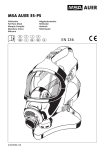
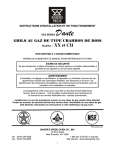

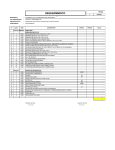

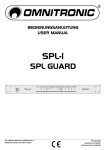

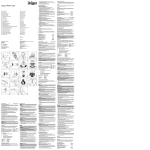
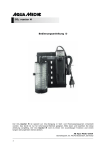
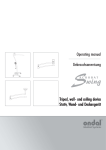
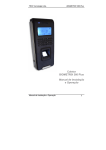
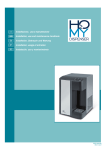
![SIRIUS® [ MultiGas Detector ] - Ex-Ox](http://vs1.manualzilla.com/store/data/005943422_1-205976de5d5a2c1a8aefcbb2de78019a-150x150.png)



